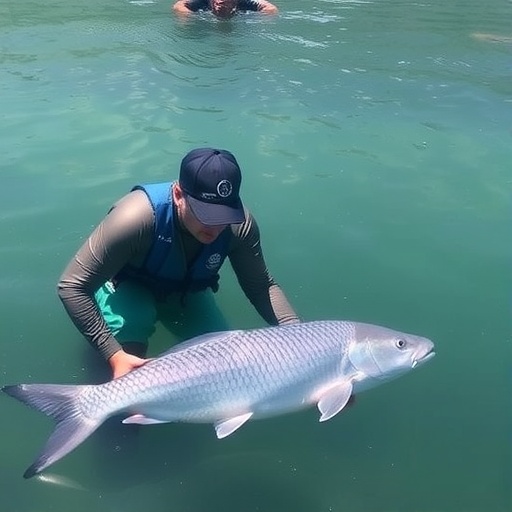Researchers are continuously exploring innovative approaches to enhance food preservation, especially in the context of aquatic species like silver carp. The preservation of such fish is crucial not only for maintaining nutritional quality but also for extending shelf life, which can result in economic benefits for the fishing industry. A groundbreaking study conducted by Hamedani et al. delves into the development and characterization of active packaging films made from chitosan infused with olibanum and enhanced by lavender nanoemulsion and titanium dioxide (TiO₂) to preserve silver carp effectively.
Chitosan, a biopolymer derived from chitin, has garnered attention as an ideal eco-friendly packaging material due to its antimicrobial properties. When incorporated with olibanum, a resin-based essential oil known for its health benefits, the resultant composite films exhibit remarkable potential in food preservation. The intrinsic properties of these materials enable them to actively interact with the packaged contents, effectively reducing microbial load and extending the fish’s usability period.
The utilization of lavender nanoemulsion represents a novel approach to enhancing the antimicrobial efficacy of chitosan films. Lavender oil, widely recognized for its antiseptic and anti-inflammatory properties, can impede the growth of spoilage bacteria and pathogens. By encapsulating lavender oil in nano-sized droplets, researchers increase its bioavailability and release rate, optimizing its protective effect on food products.
Another critical factor in this pioneering study is the incorporation of titanium dioxide (TiO₂). This inorganic compound serves multiple purposes, including acting as a photostabilizer and providing photocatalytic properties. When exposed to UV light, TiO₂ can generate reactive oxygen species that further inhibit microbial growth, thus creating a synergistic effect alongside the other active components incorporated into the chitosan films. The combination of these three elements introduces a multi-faceted approach to food preservation, ensuring that silver carp retains its freshness and nutritional value for longer periods.
Ensuring the effectiveness of the active packaging films requires thorough characterization studies. The researchers conduct a comprehensive analysis of the mechanical, thermal, and barrier properties of the chitosan/olibanum films. Techniques such as Fourier-transform infrared spectroscopy (FTIR) and scanning electron microscopy (SEM) are employed to assess the films’ structure and functionality. Such investigations reveal the interaction between the chitosan matrix and the incorporated active compounds, confirming that the combination results in a homogenous and effective film with enhanced properties.
Moreover, the authors present an in-depth study on the shelf life of silver carp packaged in the active films. Evaluating changes in the microbial load, sensory attributes, and biochemical parameters over a specified duration provides insights into the films’ effectiveness. The results showcase a substantial reduction in spoilage organisms and an extended period before quality deterioration occurs, evidencing their potential applications in the seafood industry.
In the context of environmental sustainability, replacing conventional petroleum-based packaging with biopolymer alternatives represents a significant advancement. The active chitosan films not only reduce plastic waste but are also biodegradable, underscoring a commitment to ecological responsibility. The economic implications of implementing such packaging solutions could be far-reaching, potentially benefiting both producers and consumers alike by offering a cost-effective method for preserving fish products.
Furthermore, the scalability of producing chitosan/olibanum/TiO₂ films opens avenues for commercial production. The integration of this technology within the food supply chain may lead to widespread adoption in fisheries and processing facilities. Stakeholders in the seafood market should actively consider these biopolymer films as a comprehensive solution to enhance product quality and compliance with food safety regulations.
In addition to their immediate preservation benefits, the active films also enrich the culinary experience. The inclusion of lavender and olibanum not only helps retain the fish’s integrity but also adds intriguing aromatic qualities to the final product. As consumers increasingly seek novel and artisanal food experiences, chitosan-based packaging films that enhance flavor profiles and sensory acceptance may gain popularity in the market.
The research team behind this study emphasizes that the insights derived are just the beginning. Future research endeavors are anticipated to explore further combinations of natural extracts to achieve even more potent antimicrobial effects and better film properties. The installation of a multidisciplinary approach can yield findings that contribute not only to food safety but also to holistic innovations within the broader scope of sustainable packaging solutions.
In conclusion, the work spearheaded by Hamedani et al. illustrates the vital intersection of science and industry in addressing contemporary food preservation challenges. Their findings underscore how active packaging technology can enhance the shelf life and safety of perishable goods such as silver carp. As interest in such innovative solutions grows, the implications for the seafood industry could be transformative, encouraging the adoption of sustainable practices while enhancing the overall consumption experience.
As researchers continue to navigate the complexities of food preservation, the persistence in developing biodegradable and active packaging solutions reflects a growing consciousness towards sustainability, health, and consumer satisfaction. Further exploration and acceptance of such innovations will undoubtedly shape the future landscape of food packaging and safety, making environmentally friendly and effective options more accessible to consumers and producers alike.
In summary, Hamedani et al. have made significant strides in the development of active chitosan films with essential oil infusions. Their work provides a foundation for further exploration into bio-based packaging alternatives that meet the diverse needs of the food industry while supporting environmental sustainability.
Subject of Research: Food preservation using active packaging materials.
Article Title: Development and characterization of active chitosan/olibanum packaging films with lavender nanoemulsion and TiO₂ for silver carp preservation.
Article References:
Hamedani, M.S., Rezaeigolestani, M. & Mohsenzadeh, M. Development and characterization of active chitosan/olibanum packaging films with lavender nanoemulsion and TiO₂ for silver carp preservation.
Sci Rep (2025). https://doi.org/10.1038/s41598-025-29145-5
Image Credits: AI Generated
DOI: 10.1038/s41598-025-29145-5
Keywords: Active packaging, chitosan, olibanum, lavender nanoemulsion, titanium dioxide, silver carp preservation.
Tags: active packaging technology for seafoodantimicrobial properties of chitosanbiopolymer applications in food industrychitosan films for food preservationeconomic benefits of fish preservationenhancing shelf life of aquatic speciesinnovative packaging solutions for silver carplavender nanoemulsion in food preservationolibanum-infused packaging materialsreducing microbial load in fish storagesustainable food preservation methodstitanium dioxide in packaging films





